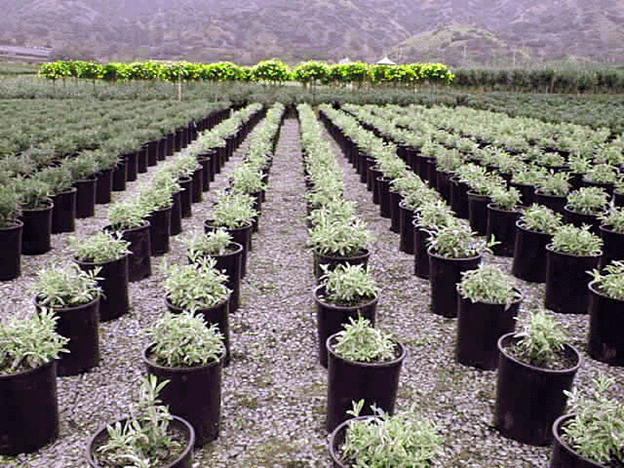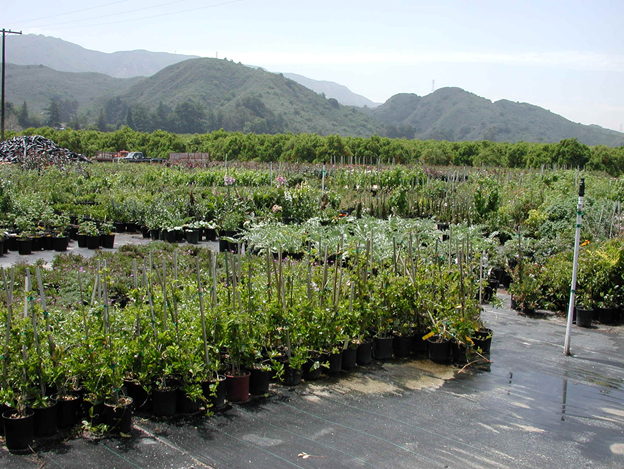GET CULTURED: Non-chemical prevention of weeds in containers
by Don Merhaut
Light
Most weeds of containerized plants require light for seed/spore germination. By minimizing light on the surface of containers, weed germination is greatly reduced. Light levels on container surfaces are usually highest directly after planting or shifting to larger containers, when the canopy of plant liners, plugs or transplants are small relative to the container size. As crops become established and the canopy develops, the plants will often shade the media surface sufficiently to reduce the likelihood of weed seed germination.
If the plant canopy is not dense enough to shade the surface of the container medium, then one should consider a weed barrier. A mulch of bark, straw, or any product that allows water to flow through the mulch to the medium can be used as a light barrier. Consider materials that are available locally, since these products are usually less expensive — for example, in pecan-growing regions, pecan shells are sometimes used by nursery growers and rice hulls are readily available for use in California nurseries. However, be careful that organic products do not carry toxic biochemicals (allelopathic chemicals) or high concentrations of salts that may cause crop injury. Likewise, if inorganic products are used, be sure that toxic residues such as heavy metals cannot leach from the products. Fabric discs are also available that are precut to fit various sizes of containers. These discs may be expensive and may blow out of containers if not secured into place. However, these fabrics can be removed and reused when the plants are sold.
Moisture
The drier the surface of the container media, the less likely weed seeds will have an opportunity to germinate. Selection of appropriate media and mulches and use of good irrigation management strategies are practices that can reduce container surface moisture and weed germination.
Media. When preparing or selecting media, be sure the substrate has sufficient water-holding capacity so that irrigation frequency can be reduced. Even plants such as azaleas, camellias and daphnes, which require a consistent moisture supply, can be grown without infestation of moss and lichens by providing a moisture-retentive, but well-drained medium.
Mulch. In addition to serving as a light barrier, coarse mulches, such as pine bark, dry out rapidly and can therefore be used to reduce germination of most weed seeds.
Irrigation. Irrigation system design and maintenance as well as irrigation practices all affect weed germination. Irrigation systems such as drip and flood can be used to moisten the container medium without wetting the surface of the medium. However, subsurface irrigation systems with recirculating water must be carefully managed to minimize the spread of pathogens in the water. Salt accumulation in containers may also be a problem in subsurface irrigation systems.
Irrigation systems in the production beds should be properly maintained to ensure that the irrigation nozzles are not leaking. When leaking irrigation heads drip onto containers, weed seeds will likely germinate, and weed infestations of production beds will begin in these areas. Weed growth will be encouraged in and around any wet areas where there are irrigation leaks.
Proper irrigation practices will also minimize the duration of soil surfaces staying moist. Infrequent, but deep irrigation should be conducted, if possible. Since most weeds develop with newly planted crops, drip irrigation to the rootball is favored. This will not only minimize weed seed germination, but also conserve water and nutrients by supplying water only to the root ball and not the entire container, where roots have not yet developed. As plants grow larger, they obviously require more frequent irrigation, but at this time canopies are usually large enough to block light on the soil surface.
Seed/Spore Sources
Eliminating weed seed sources will reduce the likelihood of weed infestations in containers.
Adjacent fields. The areas in proximity to nursery beds should be free of vegetation. If lawns and fields are maintained upwind of production beds, be sure that they are mowed or maintained so that weed seed production is minimized.
Infrastructure. Gravel, pavement, or fabrics used under containers in production beds will minimize weed growth outside of containers, especially if overhead irrigation is used (Figs. 1 and 2).

Fig. 1. A thick coat of gravel on beds prevents weed growth. Prior to gravel placement, the soil should be compacted so that the gravel does not “sink” into the soil. The placement of fabric or plastic underneath the gravel works even better than compaction.

Fig. 2. Weed-barrier fabric placed on production beds eliminates weed seed germination and growth around containers. It also reduces the incidence of diseases caused by pathogens that are splashed onto foliage from soil surfaces.
Greenhouses and shadehouses. Lichens and mosses tend to be the problem in greenhouses and shadehouses. Make sure that all containers and media are sterilized. Also, fungus gnats may spread spores, so controlling these insects will minimize lichen and moss infestations.
Cleanliness of media and mulches. All media and mulches that are used in production should be weed-seed free. Some mulches may harbor weed seeds — for example, rice hulls may contain viable rice seeds that may germinate — so be sure that these products are sanitized to kill any seeds.
Summary
If proper sanitation and cultural practices are followed, weed infestations into production beds should be eliminated or at least minimized to a controllable level. Weed control is an ideal IPM practice since absence of weeds will also reduce the incidence of pests and pathogens.
Don Merhaut is a UC Cooperative Extension Specialist for Nursery and Floriculture Crops, Department of Botany and Plant Sciences, UC Riverside.












